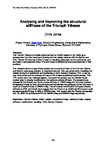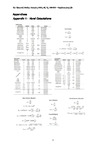Analysing and improving the structural stiffness of the Triumph Vitesse
| dc.contributor.author | Jones, Chris | |
| dc.date.accessioned | 2021-07-08T20:37:48Z | |
| dc.date.available | 2021-07-08T20:37:48Z | |
| dc.date.issued | 2021 | |
| dc.identifier.citation |
Jones, C. (2021) ‘Analysing and improving the structural stiffness of the Triumph Vitesse’, The Plymouth Student Scientist, 14(1), pp. 246-285. | en_US |
| dc.identifier.uri | http://hdl.handle.net/10026.1/17331 | |
| dc.description.abstract |
The Triumph Vitesse is a British sports car built by British Leyland in the 1960s as a development from the Herald and sharing common design features with the Spitfire and GT6. Vehicle stiffness has a direct impact on handling, passenger comfort and safety, and so modern manufacturers invest time and money in enhancing structural properties of their products. This research aimed to quantitively analyse the structural stiffness of the Triumph Vitesse and identify weak areas suitable for targeted improved. This was achieved by modelling the vehicle structure in Solidworks and conducting a Finite Element Analysis (FEA). A test rig was constructed and the torsional stiffness of the Vitesse established experimentally. The FEA results were then validated against the experimental data, and the verified virtual models used to develop modifications that enhance vehicle stiffness. The research was successful; the chassis was found to have stiffness of 1250Nm/deg with the body structure increasing stiffness by 90%, and the doors and convertible roof adding a further 20% each to reach an overall stiffness of 3500Nm/deg. Tested chassis modifications increased chassis stiffness by 37%, and virtual tests suggest that the fitment of an additional sill structure could increase overall stiffness by 35% to 5400Nm/deg. This would make the Vitesse comparable with the BMW Z3 and Mazda MX5 with 5600Nm/deg and 6000Nm/deg respectively. | en_US |
| dc.language.iso | en | en_US |
| dc.publisher | University of Plymouth | en_US |
| dc.rights | Attribution 3.0 United States | * |
| dc.rights.uri | http://creativecommons.org/licenses/by/3.0/us/ | * |
| dc.subject | Triumph Vitesse | en_US |
| dc.subject | British Leyland | en_US |
| dc.subject | structural stiffness | en_US |
| dc.subject | vehicle stiffness | en_US |
| dc.subject | chassis stiffness | en_US |
| dc.subject | modifications | en_US |
| dc.subject | handling | en_US |
| dc.subject | Finite Element Analysis | en_US |
| dc.title | Analysing and improving the structural stiffness of the Triumph Vitesse | en_US |
| dc.type | Article | en_US |
| plymouth.issue | 1 | |
| plymouth.volume | 14 | |
| plymouth.journal | The Plymouth Student Scientist |




